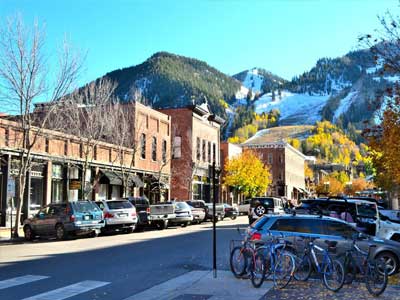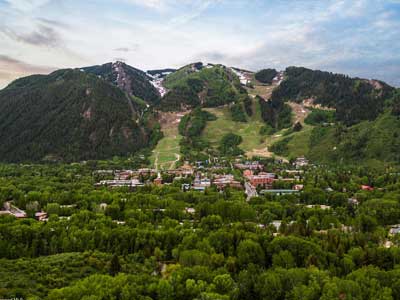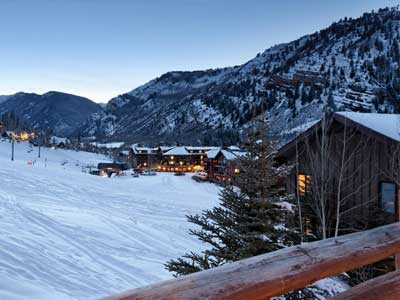Schools in Aspen, Vail and Crested Butte are reporting record interest and enrollment as part-time residents relocate to their vacation homes and urban buyers flock to mountain retreats.
Jason Blevins | @jasonblevins | The Colorado Sun — jason@coloradosun.com | JUL 27, 2020 3:40AM MDT
Urbanites fleeing cities for homes in the hills are pulling mountain resort real estate out of a pandemic slump.
Inventories are dwindling, prices are soaring and resort-town schools are seeing enrollment climb as second-home owners and newcomers settle in places like Steamboat Springs, Vail, Crested Butte, Telluride and Aspen.
“I think a lot of people already had it on their minds for some time and they are seeing how their kids are flourishing out here and they are maybe more aware of the challenges in the urban environment,” said Darin White Eydenberg, who is enrolling her three children in a private school near their Aspen vacation home as she and her husband avoid returning home to New York. “In many ways, this feels like a fantasy. We have always talked about working from home, but it has not been a reality like it is now.”
Aspen broker Tim Estin calls it “The Great Urban Exodus.”
“This event is a trigger for buying. People who have been on the fence are buying. People who have been spending time here for years are moving into bigger properties,” said Estin, noting that the high-end rental market also is exploding as visitors prolong their summer vacation into fall and winter.
Estin is among dozens of local brokers who spent decades pitching real esate in Aspen, Co and Snowmass Village as a safe harbor for investments. For all but a few of those years they were right. Multimillion-dollar homes in Aspen appreciated better than most other investments until the Great Recession, when spectacularly high home prices and a buying frenzy in 2007 collapsed into a glut and a rut that lasted until 2013 in the Roaring Fork Valley.
The recent surge of activity reminds Estin of that 2007 boom. New Aspen real estate listings are coming on the market with exceptionally high prices and buyers are scooping them up. He’s sold some properties to out-of-state buyers who aren’t even visiting the home in person. In the first two weeks of July, 111 homes went under contract in the Aspen area. That compares with 46 in the first two weeks of July 2019, Estin said.
But Estin feels something different about this boom. Buyers aren’t parking money as an investment. They are buying homes they plan to move into — and not just for vacations.
“Everything is going wild right now. People are wanting to get out of the density of the urban environment and they are wanting physical space and safety,” Estin said. “There’s is high uncertainty and insecurity and there is something of a sentiment like, ‘If the whole world crashes and this COVID gets worse and worse, I’d rather be in Aspen than New York City or Miami or Dallas or Houston.’”
The year of the second-home owner
The booming mountain market reflects a national trend showing a huge spike in sales in June, snapping a three-month decline. Dwindling inventories and tumbling mortgage rates drove a 21% increase in home sales in June compared with the previous month, according to the monthly summary released Wednesday by the National Association of Realtors. And housing experts expect the trend to continue, pointing to rising mortgage applications and steadily increasing prices.
The latest report from the U.S. Census Bureau, which tracks new home construction as one of more than a dozen national economic indicators, shows a 1% decline in housing permits across the U.S. in June, compared with June 2019. New home permits issued in June climbed 12% over May. For the year, permits are up 3.4% compared to 2019.
For homes that are permitted but not yet started, the Census Bureau reported national numbers are up more than 11% in June compared to June 2019. In the 13-state West, the number of permitted homes not yet under construction is up more than 14%.
Kevin O’Donnell, the president of the Vail Valley’s super high-end Beck Building Co. has seen a wave of new interest from part-time residents looking to renovate their vacation homes for full-time living and newcomers hoping to settle with young families in the valley.
The company recently bid projects for two families that were moving to the mountains from larger metro areas. O’Donnell has seen recent bidding wars on properties he built as inventories drop in the Vail Valley.
The current city flight has similarities to the spike in mountain homes sales that followed 9/11.
“There were a number of people who relocated here full-time after 9/11, saying that it was simply too uncomfortable for them to be in the city,” said O’Donnell who has been with Beck for 24 years. “The difference now is that we have proven you can work from home. That was not the case in 2001, right? Now you can hold your job and work remotely and live in the safety of the mountains.”
Heading into this summer, resort communities embraced part-time residents as the economic foil to declining tourism. “The summer of the second-home owner” they called it, sculpting specific campaigns to entice non-resident property owners to come for prolonged stays and help float economies wilting without a steady flow of tourists. Now it’s become the year of the second-home owner.

The Aspen Country Day School in in Aspen, Colo., Thursday, July 23, 2020. The private school has seen enrollment inquiries double as more second-home owners settle in the Roaring Fork Valley. (Barton Glasser, special to The Colorado Sun)
From a tourism economy to a “lifestyle” economy
The migration also is filling resort-town schools. Across the high country, school districts and private schools are seeing unprecedented enrollment and interest as a wave of newcomers settle in mountain valleys.
David Baugh, the superintendent at Aspen School District, said 30 to 35 new students typically enroll each year. This summer, enrollment has soared at the preschool, elementary, middle and high school, and the district is expecting 150 new students.
“They are all ages, but that is about an extra graduating class in a really good year,” Baugh said. “We are of course happy to welcome these folks and I can say anecdotally there are quite a few cars with Texas, New York, California and Arizona tags in town. We have asked all newcomers to self-quarantine for 14 days before entering school.”

Children play outside Aspen High School in Aspen, Colo., Thursday, July 23, 2020. School district administrators are making plans for reopening the school. (Barton Glasser, special to The Colorado Sun)
Gunnison Watershed District Superintendent Leslie Nichols said her six schools are “braced” for new students this fall. New residents from Golden, Denver, Austin, New York and all over Texas are already visiting her schools. Crested Butte Secondary School, with grades 6 to 12, has 455 students enrolled, up from 431 last year. Crested Butte Elementary is up to 378 students, from 342 last year. For the last several years, growth at Gunnison Watershed District schools has averaged 28 new students a year.
“The growth already exceeds the typical new enrollment for sure and it’s only July 20,” Nichols said. “We anticipate more.”
Josh Wolman is fielding many calls from families inquiring about spots at Aspen Country Day School. The head of the private school isn’t increasing capacity much — maybe an additional 10 students to last year’s 270 — but his wait list is growing.
“We are not going to have a school that is overfilled,” Wolman said. “We are managing interest as best we can. We do have twice as many inquiries as last year and that, for us, is a lot. I think people are realizing that Aspen and the Roaring Fork Valley offer an outstanding education and a great place to raise children. I think it’s pretty exciting to see the interest.”
Vail Mountain School has the longest wait list in the nearly 60-year-old private school’s history.
The K-12 Vail Mountain School has enrolled 445 students for the 2020-21 school year, which is maximum capacity. That’s about 20 students more than last year.
“We are seeing a lot more interest from people who have decided that Vail is a healthy, safe place to be in these times and they are looking for a good school for their children,” said school spokeswoman Kathleen Hogan. “We have interest and applicants for all grade levels. We are still talking to families and asking them to visit and apply. We have a wait pool. And yes, it’s never been so big.”
Jon Wade, a longtime Steamboat Springs broker, is seeing the pandemic amplifying trends that have been slowly taking shape in Routt County over the last several years. Wade says Steamboat’s slow transition from a resort economy anchored in visiting skiers and tourists to “a lifestyle economy” reliant on a growing number of residents moving to the Yampa River Valley has accelerated with the spread of COVID-19 in urban locations.
Steamboat Springs has a growing population of high-earning, home-based workers who could be anywhere but choose to live in Routt County. That location-neutral workforce is attracting more businesses as industries recognize the value and efficiency of remote working during the pandemic, Wade said.
After a strong start to the year, real estate activity in Routt County collapsed in April and May. Things picked back up in June, and July has been one of the busiest months ever, Wade said. He expects the busy July will leave the county only 10% behind last year’s record pace.
“People are wanting to get away from cities,” said Wade, who is offering to waive his sales commission for up to three local families that have to sell because of the pandemic. “More people are realizing they can work from home and instead of coming here for two to four weeks, they are thinking about coming here for two to four months. Or even longer.”
Wade also sees similarities to the booming sales of 2007. But like Aspen’s Estin, Wade sees recent sales activity as “very logical and reasoned,” and unlike the irrational exuberance that fueled the 2007 market.
“These people who are buying, they want to use the properties. Sure it’s an investment, but they want to be a part of this community,” he said. “They are saying ‘We want to be here for 10 years or longer. If there’s a dip, I’m comfortable with that.’ It feels like people are pursuing their long-term plan to move up here. COVID has pushed them to make that decision now.”
No discounts, little negotiation
Brad Meeks, the superintendent of the Steamboat Springs School District, said fall enrollment remains “a big question.” He has heard about new arrivals but has not seen their numbers on his enrollment charts.
“We have budgeted for a 5% reduction in enrollment due to the pandemic,” Meeks said. “We will start to get a clear picture in early August.”
Wade said he feels “a duty” to give back by waiving fees for families who may be suffering in the economic collapse surrounding the pandemic. Across the high country, the wave of wealthy COVID-19 refugees could transform local communities in a way that might leave seasonal workers and lower-income locals even more stressed in their search for affordable housing.
Frank Reeves, the superintendent of the East Grand School District, expects any new families relocating to the Fraser River Valley will be offset by families burdened by the pandemic’s toll on jobs, wages and housing. He is fielding a few calls a week from work-at-home newcomers settling in their vacation homes for the long-term or building new houses, and he expects that 20 to 30 new enrollees will be balanced by departing families fleeing the climbing prices for housing and soaring unemployment.
“We are hoping to at least break even or be up a few,” Reeves said.
Grand County’s real estate sales are pacing ahead of last year’s all-time record, with a strong January and February balancing out declines in April and May. Grand County often sees a majority of its sales going to Front Range buyers, and that trend continued through May, with 61% of the county’s $240.1 million in sales involving buyers from metro Denver, according to data gathered by Land Title Guarantee Co.
East Grand hopes to open its five schools on Aug. 26, but Reeves said Grand County needs to see the number of positive COVID-19 cases decline if it expects to have students in classrooms by then.
Grand County and Eagle County have seen a recent uptick in positive test results for residents with COVID-19, triggering a reduction in sizes of gatherings and other regulations designed to limit the spread of the contagion. The Western Slope’s Grand, Eagle, Pitkin, Garfield and Chaffee counties were notified last week by the state health department that they are at risk of losing variances that allowed them to expand openings beyond state limits.
Families leaving town or simply not enrolling their kids in school might offset any new arrivals in Telluride too, said school district superintendent John Pandolfo.
Pandolfo has fielded “a few commitments” from new arrivals at his district’s three schools, but that’s balanced by families who are opting out of schools or possibly leaving the community.
“It is hard at this point to see where we will end up,” he said.

A trail in Telluride, Colorado. (Jesse Paul, The Colorado Sun)
George Harvey has been selling real estate in Telluride since 1984. This year, he saw second-home owners staying in their homes during the off-season after the ski area abruptly closed in mid-March. Students and parents joined grandparents, riding out the quarantine in homes typically used for holidays.
“Everybody seems to be hiking and enjoying the outdoors at a level I’ve never seen before,” he said. “I think Telluride — like all resort town in Colorado — was appreciated in a really different and fundamental way during this pandemic.”
Harvey is working with more buyers than ever before. The market is busier than it was in 2007, he said. Buyers are grabbing properties at all levels of the market, he said, from the multimillion-dollar mansions to the tiny condos.
“There is no question their sense of urgency has changed. If someone has ever said they wished they could spend more time in Telluride, well now they are committed,” Harvey said. “Instead of back home being their base, this is their new base and back home is a place they might visit.”
Real estate sales for the first six months of the year will be about 26% ahead of last year, Harvey said. The number of transactions is up 17%.
“There are no deals and very little negotiation,” he said. “Demand is just too great right now.”






















0 Comments